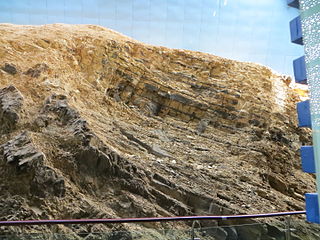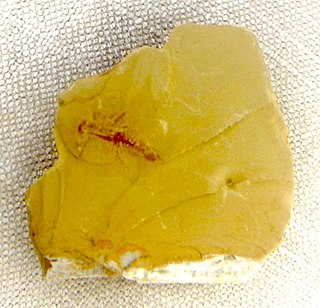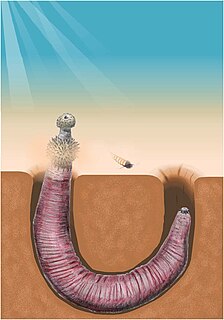
The Maotianshan Shales are a series of Early Cambrian deposits in the Chiungchussu Formation, famous for their Konservat Lagerstätten, deposits known for the exceptional preservation of fossilized organisms or traces. The Maotianshan Shales form one of some forty Cambrian fossil locations worldwide exhibiting exquisite preservation of rarely preserved, non-mineralized soft tissue, comparable to the fossils of the Burgess Shale. They take their name from Maotianshan Hill in Chengjiang County, Yunnan Province, China.

Parapeytoia was a prehistoric animal that lived over 530 million years ago in the Maotianshan shales of prehistoric China. It was interpreted as an anomalocaridid (radiodont) with legs, but later studies reveal it was a megacheiran, a group of arthropods which are no longer thought to be closely related to the radiodonts.

Acanthomeridion is an extinct arthropod found in the Chengjiang fauna deposits of China. In 1997, it was placed in its own, monotypic family, Acanthomeridiidae. It is known from eight specimens, all found in China.

Facivermis is a genus of sessile lobopodian from the Lower Cambrian Maotianshan shales of China

Class Xenusia, the Xenusiids, represents the subset of lobopodian worms that fall in the stem-lineage of Onychophora. Their type genus is Xenusion. They have relatively large, annulated, cylindrical bodies. Their lobopod legs have tubercles at their bases. Some have large frontal appendages, although these may represent taphonomic artefacts. Their mouth is terminal or subterminal, and they are marine. They probably represent a grade rather than a clade.

Cindarella is genus of trilobite-like Cambrian arthropod known from the Chengjiang biota of China. It is classified as a stem group of trilobites in the clade Xandarellida, along with Phytophilaspis, Sinoburius, and Xandarella.
Kuamaia is an extinct genus of artiopodan in the phylum Arthropoda. Fossils of the type species K. lata were discovered in the Chengjiang biota. The closely related congeneric species K. muricata has also been identified there, but neither species has been found elsewhere.

Archaeopriapulida is a group of priapulid-like worms known from Cambrian lagerstätte. The group is closely related to, and very similar to, the modern Priapulids. It is unclear whether it is mono- or polyphyletic. Despite a remarkable morphological similarity to their modern cousins, they fall outside of the priapulid crown group, which is not unambiguously represented in the fossil record until the Carboniferous. They are probably closely related or paraphyletic to the palaeoscolecids; the relationship between these basal worms is somewhat unresolved.

Phytophilaspis is a phosphatized genus of trilobite-like arthropod with eyes, found in association with algal remains. It dwelt in well-lit, shallow waters.

The Luolishaniidae are a group of lobopodians with setiferous forelimbs known from the Cambrian period. The presence of thorn-shaped sclerites arranged as three per segment is diagnostic. The type genus is based on Luolishania longicruris Hou and Chen, 1989, from the Chengjiang Lagerstatte, South China. They are presumed to have been filter feeders. New specimens of the previously engimatic Facivermis show that it was a sessile tube-dweller, and part of this group.

Lyrarapax is a radiodont of the family Amplectobeluidae that lived in the early Cambrian period 520 million years ago. Its neural tissue indicates that the anomalocaridid frontal appendage is protocerebral, resolving parts of the arthropod head problem and showing that the frontal appendage is homologous to the antennae of Onychophorans and labrum of euarthropods. Its fossilized remains were found in Yunnan in southwestern China. A second species was described in 2016, differing principally in the morphology of its frontal appendages.
Archotuba is a genus of elongated conical tubes that were seemingly deposited by colonial organisms. Known from the Chengjiang, its biological affinity is uncertain; it somewhat resembles the tubes of the 'priapulid' Selkirkia, but a cnidarian affinity is also possible. In the absence of soft parts, there really isn't enough data to confirm a biological affiliation.

Iotuba chengjiangensis is a problematic Cambrian fossil with a U-shaped gut and tentacles, known from the Chengjiang biota. Originally interpreted as a phoronid marine animal, its affinity is currently disputed. It, and the possibly-synonymous taxon Eophoronis, resemble the 'priapulid' Louisella.

The Artiopoda is a grouping of extinct arthropods that includes trilobites and their close relatives. It was erected by Hou and Bergström in 1997 to encompass a wide diversity of arthropods that would traditionally have been assigned to the Trilobitomorpha. Hou and Bergström used the name Lamellipedia as a superclass to replace Trilobitomorpha that was originally erected at the subphylum level, which they considered inappropriate.

Beidazoon venustus is a deuterostome from the deuterostome group Vetulicolia. It originates from the lower Cambrian Chengjiang biota of Yunnan Province, China. Beidazoon was a marine organism discovered by Degan Shu in 2005.
Prototreta flabellata is one of several species of brachiopod that occur in the Cambrian rocks of central and southern Montana, Nixon Gulch section, Three Forks Quad. It is associated with the trilobite genus Ehmania near the base of the Middle Cambrian Meagher limestone.

Squamacula is an extinct arthropod from the Cambrian Series 2, the type species S. clypeata was described in 1997 from the Chengjiang biota. At the time of description there were only two known specimens of S. clypeata, but now there are at least six known specimens. In 2012 a second species S. buckorum was described from the Emu Bay Shale of Australia.
Fuxianospira gyrata is a Cambrian macroalgae found in the Chengjiang lagerstatte. Preserved in clustered, helicoid groups, the filaments are threadlike, plain and without branches. Brown and smooth in appearance, these structural characteristics display a resemblance to modern brown algae. A limited amount of algae species have been discovered in the Chengjiang biota, suggesting that diversity within the general algae population may have been sparse. It is thought that the macroalgae could be the most basic component of the Chengjiang biota food chain.

Xandarella is an extinct genus of Xandarellid artiopodan known from the Cambrian of China and Morocco, the type species was described in 1991 from the Chengjiang Biota in China. An additional species Xandarella mauretanica was described from the Cambrian Stage 5 Tatelt Formation in Morocco in 2017, which only preseved the ventral anatomy. Like other Xandarellids, the exoskeleton is unmineralised. The cephalon has pronounced eye slits, presumably derived from ancestral ventral stalked eyes.

Luohuilinella is an extinct genus of xandarellid artiopodan arthropod known from the Chengjiang biota of China. The type species Luohuilinella rarus was described in 2012 A second species Luohuilinella deletres was described in 2018. Both taxa are rare components of the assemblage. Like other Xandarellids and most artiopodans, it possessed an unmineralised exoskeleton. The type and currently only known specimen of L. rarus is known from a dorsal exoskeleton, around 17 mm long and 9 mm wide which consists of 27 tergites with pronounced pleural spines. L. deletres is much larger, with specimens being over 10 cm long, L. deletres possessed at least 11 pairs of biramous appendages. Both taxa are dorsoventrally flattened, making a benthic or nektobenthic lifestyle probable. Both taxa have pronounced notches in the cephalon to accomodate the stalked eyes.


















